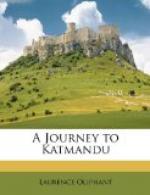The Itala musjid, to which we next bent our steps, has been built on the site of one of these temples; its cloisters remain untouched, and the figures on almost every slab bear undoubted testimony to the previous existence of a Jain temple on this spot. The large square rooms, which were filled during our visit with true believers, were curiously roofed; a dome was ingeniously thrown over the square. An octagon, placed on solid buttresses, supported a 16-sided figure, which in its turn supported the dome. The Jumma musjid, which we also visited, was remarkable for its magnificent screen, 120 feet in height by 70 in breadth, and covered with curious inscriptions and fantastic devices; the top is slightly narrower than the base, tapering in depth as well as in breadth.
The population of Jaunpore is about 35,000; there is a small European station near the town. In the course of the evening’s drive I saw a specimen of the Addansonia or baobab-tree: the trunk, measuring 23 feet in circumference, was perfectly smooth and the branches were destitute of leaves. There are but five other specimens in India, and not many in Java, where the tree was discovered by Mr. Addanson; it is said to have attained, in some instances, the enormous age of 2000 years.
Leaving Jaunpore about midnight, I reached the camp of Jung Bahadoor on the following day. The scene as we approached was in the highest degree picturesque; 5000 Nepaulese were here collected, followers, in various capacities, of the Prime Minister, whose tents were pitched at a little distance from the grove of mango-trees which sheltered his army and retainers. On our arrival he was out shooting, so, mounting an elephant, we proceeded to join him. We heard such frequent reports of fire-arms that we fully expected to find excellent sport; great was my disappointment, therefore, when I saw him surrounded by some 20 or 30 followers, who held umbrellas, loaded his guns, rushed to pick up the game, or looked on applaudingly while he stealthily crept up to take a deliberate pot shot at some unlucky parrot or small bird that might catch his eye as it perched on a branch, or fluttered unconsciously amongst the leaves. But the most interesting object in the group was the lately-wedded bride, who was seated in a howdah. Jung introduced her to me as “his beautiful Missis”—a description she fully deserved. She was very handsome, and reflected much credit on the taste of the happy bridegroom, who seemed pleased when we expressed our approval of his choice.
Before quitting the subject of Jung’s shooting-party, I must remark, in justice to him as a sportsman, that he considers nothing less than a deer to be game at all. Tiger or rhinoceros shooting is his favourite sport, and he looks upon shooting a parrot, a snipe, a hawk, or a partridge as being equally unworthy of the name of sport, nor does he understand why some of those birds should be dignified with the name of “game,” and the others not.




